Bali, an indonesian island, is often referred to as the ‘Island of Gods.’ It stands as a magical vacation destination, offering a unique blend of natural beauty, cultural richness, and a variety of activities, complemented by a tropical climate.
The island’s beauty is unparalleled, with lush rainforests, iconic rice terraces, pristine beaches, and spectacular volcanic mountains like Mount Batur, which is famous for its sunrise treks. The Ubud Art Market, a bustling maze of stalls, is an ideal spot for picking up unique handmade crafts, paintings, and sculptures.
Nature enthusiasts will be mesmerized by the lush Tegallalang and Jatiluwih rice terraces, renowned for their breathtaking emerald hues and traditional irrigation systems. For a touch of adventure, explore the Sacred Monkey Forest Sanctuary in Ubud, home to playful macaque monkeys and ancient temples.
Additionally, the island boasts luxurious beach clubs, exquisite dining, and vibrant nightlife, particularly in areas like Seminyak, known for its designer boutiques and stylish beach resorts.
Bali caters to all preferences, providing unique attractions and activities and ensuring a magical experience.
Best Times to Visit Bali for Smaller Crowds
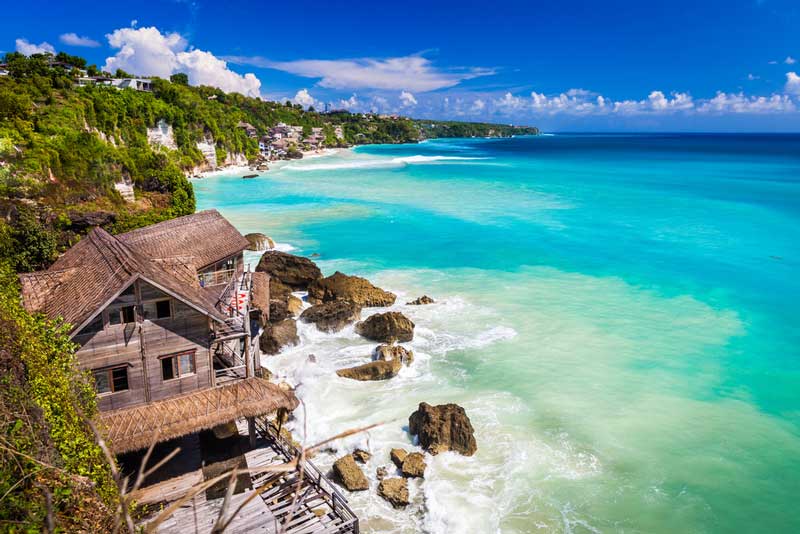
Bali, Indonesia
To visit Bali with fewer crowds, consider timing your trip outside of the peak season months. Peak season in Bali typically includes July, August, and December, when the island sees the highest number of tourists due to school holidays and favorable weather conditions.
The quietest times to visit Bali, when crowds are at their most sparse, are during the low season, which spans from February to April. However, this period aligns with Bali’s rainy season, which may deter some visitors.
Despite this, the transitional months of late March and early April can offer a balance of good weather and fewer tourists.
Another recommended period is May, June, and September, which are known for fewer crowds, cheaper prices, and generally good weather, making them ideal for visiting Bali without the usual tourist rush.
Remember, while the rainy season, spanning from November to March, might deter some visitors due to frequent showers, it also brings the benefit of lower costs and smaller crowds. For those who don’t mind a bit of rain, this can be an opportune time to explore Bali with fewer tourists around.
Best Times to Visit Bali for Good Weather
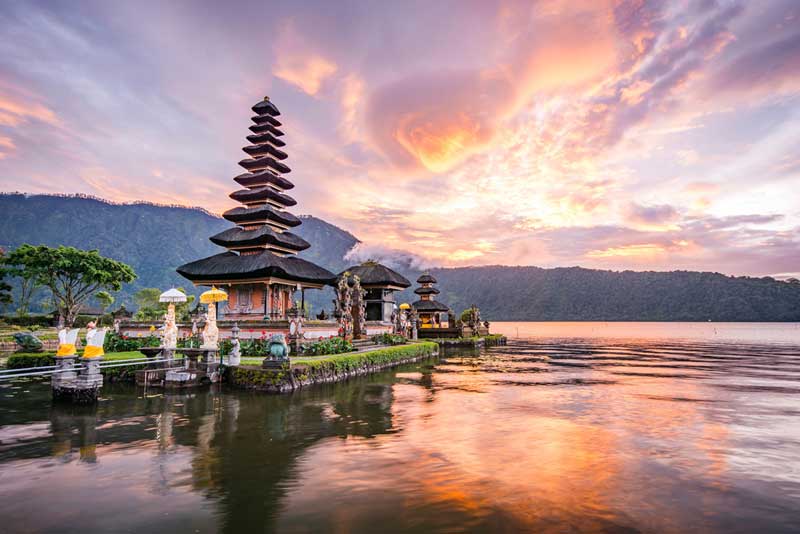
Pura Ulun Danu Bratan, Hindu temple Bali, Indonesia
The best time to visit Bali for good weather is during the dry season, which generally spans from April to October. April marks the onset of the dry season, offering a mix of sunny days and occasional rain. This transition period often has lower humidity, making it a comfortable time to visit.
May signifies the start of the driest period of the year with abundant sunshine, making it an excellent time for beach activities and outdoor exploration. June continues this trend with great beach weather and dropping humidity levels.
July and August are peak tourist months in Bali, characterized by sunny, clear skies and minimal rainfall. However, these months also see the highest number of tourists, so expect busier beaches and tourist spots.
September remains a favorable time with good weather and somewhat smaller crowds. As you move into October, the weather starts to shift, with an increase in rainfall, though there are still many sunny days.
It’s important to note that even during the rainy season, Bali can still be a pleasant destination. The rain showers are often brief, and the island still enjoys periods of sunshine.
Best Times to Visit Bali for Lower Prices
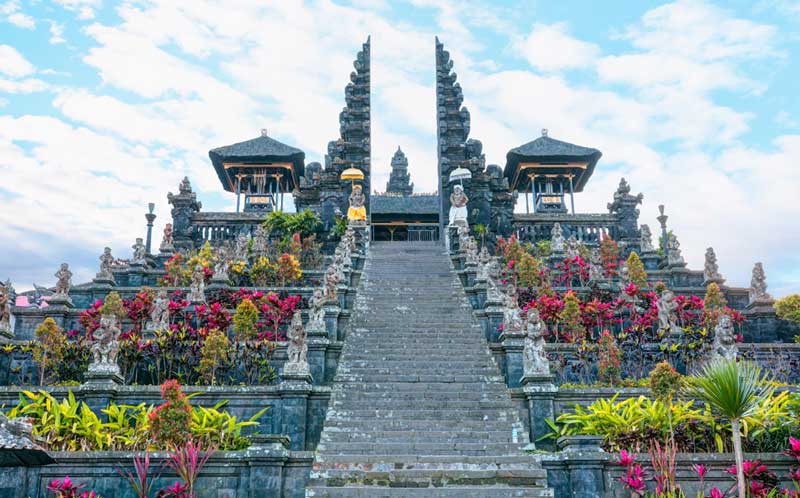
Pura Besakih temple, Bali
The best times to visit Bali for lower prices are typically during its rainy season, which spans from October to March. This period is known for moderate rainfall, storms, and cooler temperatures, but it doesn’t necessarily hinder the overall experience of the island.
In fact, many find the rainy season manageable and even enjoyable, with opportunities to engage in various indoor and outdoor activities.
December, particularly late December, experiences a mini high season due to the Christmas and New Year celebrations, drawing more visitors and slightly higher prices. However, outside of these two weeks, the rest of the rainy season is considered off-peak, offering significantly discounted accommodations and hotel rates.
January is noted as the rainiest month, but it’s also when you’ll find the best deals on hotels and flights, along with less crowded tourist spots. The weather, while rainy, often includes sunny intervals that allow for enjoyable exploration of the island.
February and March continue with the rainy trend, but with fewer tourists, providing a quiet and relaxed environment. Accommodation and flight prices are usually more affordable during these months, making them an ideal time for budget-conscious travelers.
The transitional months of late March and early November also offer a balance of good weather, fewer crowds, and lower costs, making them attractive for those seeking both value and a pleasant climate.
Best Months for Hiking in Bali

Bali island in Indonesia
The best months for hiking in Bali are during the dry season, which runs from May to October. This period is characterized by clear skies and minimal rainfall, making it ideal for outdoor activities like hiking.
May marks the start of the dry season and offers a good balance of improving weather and fewer tourists before the high season kicks in. This month provides a great opportunity for hiking with less crowded trails and more comfortable conditions.
June to August are the peak months of the dry season, offering excellent weather for hiking. However, these are also the busiest months for tourism, so popular hiking trails may be more crowded.
September is another great month for hiking, as it still offers good weather but with smaller crowds compared to the peak summer months.
October, while still part of the dry season, sees the beginning of the transition to the wet season. The weather can be more unpredictable, but there are still plenty of opportunities for good hiking days.
Best Time to Hike Mount Batur

Mount Batur, Bali
Mount Batur, an active volcano located in the central highlands of Bali, offers a popular hiking experience known for its stunning sunrise views.
The hike to Mount Batur typically takes about 1.5 to 2 hours to reach the summit. Most hikers start their journey early in the morning to catch the sunrise from the peak, making the trek in the dark hours of the morning.
The best time to hike Mount Batur is during Bali’s dry season, which spans from April to October. During these months, the weather is more predictable, with less chance of rain, making the hiking conditions safer and more enjoyable.
August is considered the optimal month for this hike as it is the driest month, with lower chances of rainfall and mild temperatures, enhancing the overall hiking experience. However, it’s important to note that this period also coincides with Bali’s peak tourist season, so the trails might be more crowded.
Best Times to Visit Bali for Festivals
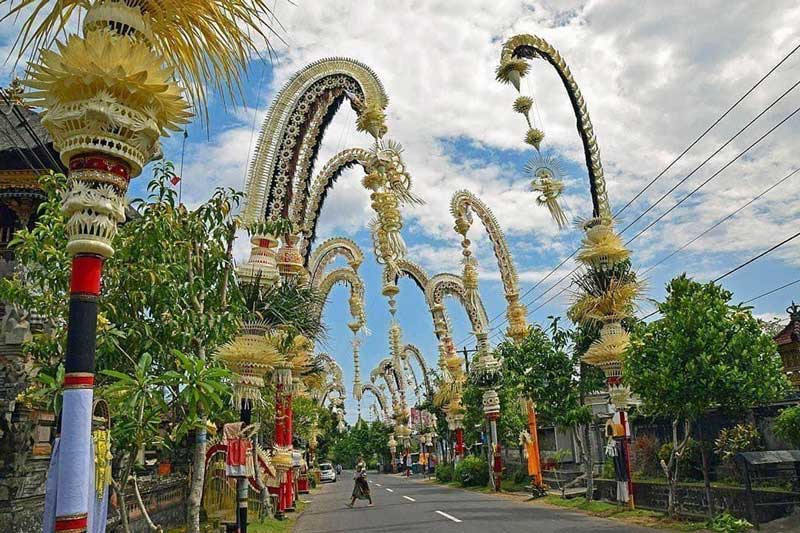
Galungan and Kuningan festivals in Bali
The best times to visit Bali for festivals are during specific months when major cultural events take place. February is notable for the Galungan and Kuningan festivals, which are significant Hindu celebrations marking the victory of good over evil.
These festivals are characterized by colorful art displays, traditional dances, and vibrant cultural activities.
In March, Bali observes Nyepi, the Balinese New Year, known for its unique tradition of complete silence and introspection. This day of stillness transforms Bali into a serene haven, offering a unique experience for visitors.
Another highlight in March is the Ogoh-Ogoh Parade, held on the eve of Nyepi. This parade features large, artistically crafted demonic figures paraded through the streets, symbolizing the purification of the environment from evil spirits.
The Bali Kite Festival, usually held in July, is another cultural spectacle. Taking place in Sanur, it features a stunning display of traditional kites, making the most of the dry season’s strong winds.
These festivals offer a rich glimpse into Bali’s cultural heritage and are ideal for travelers seeking to experience the island’s traditional and spiritual aspects.
Best Months to Visit the Beach in Bali

Kuta, Bali
The best months to visit the beaches in Bali are during the dry season, which typically runs from April to October. This period offers clear skies, minimal rainfall, and sunny weather, making it ideal for beach activities.
May and June are particularly recommended for a more relaxed and sunny experience. These months provide a balance between good weather and fewer tourists, resulting in less crowded beaches and more affordable accommodation options. The water visibility is also better during this period, which is great for snorkeling and diving.
July and August are the sunniest months, but they also mark the peak tourist season. While the beach weather is excellent, expect higher prices and more crowded conditions.
September continues to offer good weather with occasional rain and is less crowded, making it a good choice for those looking to avoid peak season crowds.
For those interested in diving, October is still a viable option as the waters remain clear, though it starts to see more rainy days.
Overall, May, June, and September offer a great mix of favorable weather conditions and fewer tourists, making them some of the best months for beach visits in Bali.
Worst Times to Visit Bali
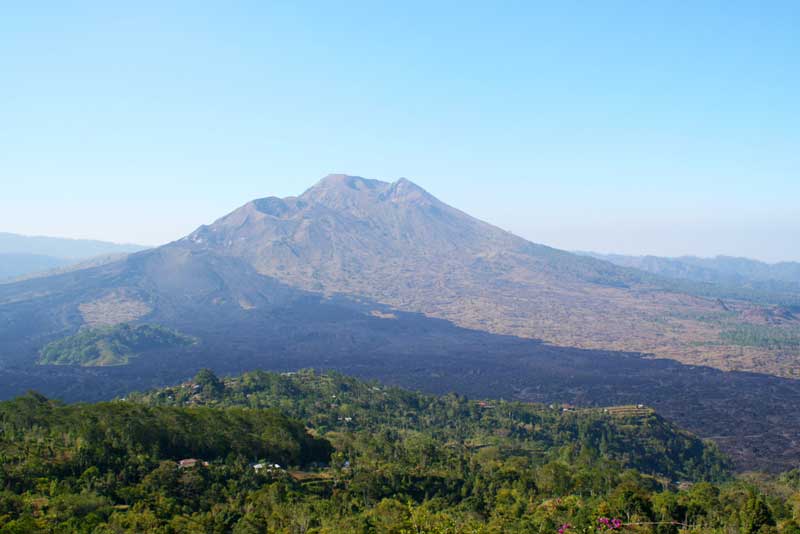
Volcano Batur, Bali
The worst time to visit Bali is generally during the rainy season, which typically spans from November to March. During these months, the island experiences higher humidity, frequent rain showers, and occasional thunderstorms.
This weather can limit outdoor activities, such as beach visits and hiking, and can lead to flooding in some areas. December to February are particularly challenging due to peak monsoon rains. Skies open up with intense downpours most days, and the combination of heat and moisture can feel oppressive.
Despite this, these months also see a surge in tourism around the holiday seasons, leading to higher prices and crowded conditions. However, it’s worth noting that Bali has its unique charm even during the rainy season.
The island becomes quieter with fewer crowds, and the abundant rainfall results in lush green landscapes and mighty waterfalls. Accommodation and flights are usually cheaper during this period, offering good deals for budget-conscious travelers.
Final Thoughts
Bali stands out as a magical vacation destination, captivating travelers with its diverse allure. It offers an enchanting mix of culture, nature, and leisure. Its rich cultural tapestry is showcased in traditional dances, intricate art, and temple festivals.
The island’s natural beauty, with its lush rice terraces, majestic volcanoes, and stunning coastline, provides a backdrop for endless adventure and relaxation. With a climate that caters to year-round travel, Bali remains an irresistible slice of paradise.
